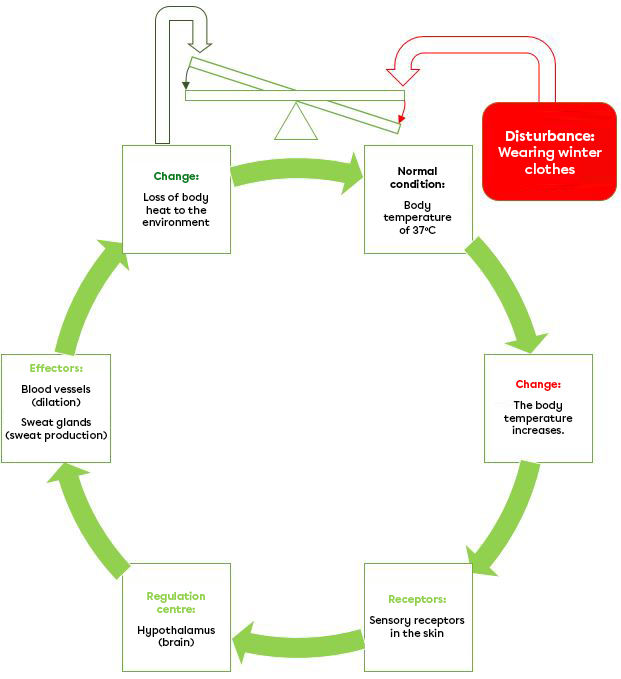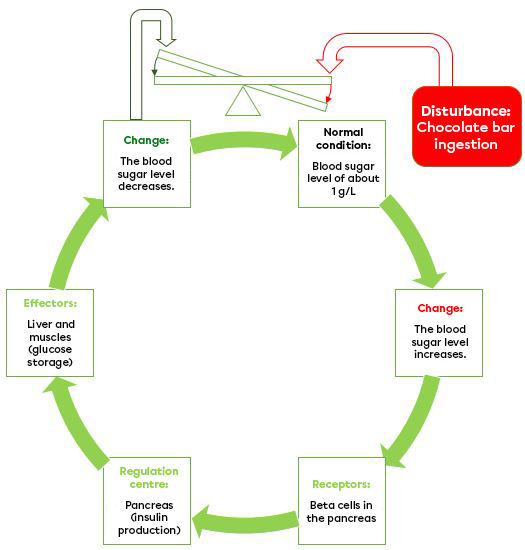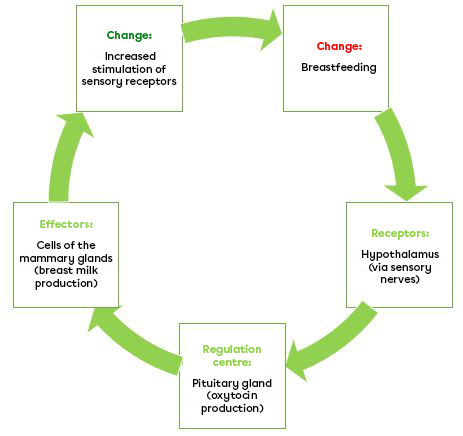The body must be able to maintain a certain balance to function properly. The pituitary gland, located at the base of the brain, monitors the concentration of minerals in the blood, the blood pH and the amount of water in the body. These parameters can be affected by the lungs, kidneys and sweat glands.
The lungs help maintain a properly balanced metabolism by removing carbon dioxide |(\text{CO}_2)| which lowers the pH of the blood if present in excess amounts. A normal blood pH value is 7.35-7.45. However, when exercising without proper oxygenation, the concentration of carbon dioxide |(\text{CO}_2)| produced by the cells through cellular respiration increases in the bloodstream, and the pH can fall below normal levels. It is crucial that the pH remains stable to allow efficient chemical reactions in the body. To remedy this, the respiratory rate will increase, removing more CO2 and raising the pH. If this is not enough, the kidneys can also adjust the pH by producing more acidic urine.
The kidneys are important to maintaining a balanced metabolism, because they’re responsible for filtering the blood and removing certain potentially harmful substances from the bloodstream. Drinking a lot of water dilutes the minerals in the blood and lowers their concentration. In response, the pituitary gland directs the kidneys to remove more water from the bloodstream and bring the concentration of minerals back to normal. On the other hand, when too much salt is consumed, the kidneys absorb less water and more minerals to reduce the concentration.
The sweat glands can restore balanced metabolism by changing the composition of sweat. Sweat contains water, nitrogenous waste and minerals. It has a similar composition as urine, but more diluted. Heavy sweating from sustained physical activity results in the loss of water and, in response, the kidneys remove less water from the bloodstream.
The concepts covered in this section are more advanced than those covered in secondary school. This is an enrichment for students who are curious to find out more.
Homeostasis is a phenomenon in which a factor, such as body temperature, is maintained at a constant value through various regulatory processes.
The human body is an open system continuously exchanging with the external environment. These exchanges can involve gaining or losing matter and energy. The cells are the main components responsible for these exchanges. They must maintain an equilibrium of their chemical (e.g., pH) and physical (e.g., temperature) characteristics.
To do this, the human body has regulatory mechanisms that allow the cells to react should these parameters deviate from the normal.
Here are some parameters that can be controlled by the human body.
-
Body temperature
-
Amount of water in the body
-
Amount of sugar in the body
-
Concentration of salts in the cells
-
Stress
Several factors can be adjusted to regulate the human body and return it to equilibrium.
-
Increased or decreased heart rate.
-
Increased or decreased respiratory rate.
-
Dilation (opening) or constriction (closing) of blood vessels to adjust the amount of blood flowing through the body (variation in blood pressure).
-
Increased urination to remove excess water and salts.
-
Increased sweating to eliminate excess water and salts through sweat and to lower the body temperature.
-
Increased contractions by the muscles to produce heat.
-
Increased or decreased hunger or thirst.
The hypothalamus, a structure of the central nervous system located in the brain, partially controls these regulatory mechanisms. This structure provides the link between the nervous system and the endocrine system that controls the production of hormones. It works in conjunction with an endocrine gland—the pituitary gland—responsible for producing many hormones in the body, including growth hormones and sex hormones.
The concepts covered in this section are more advanced than those covered in secondary school. This is an enrichment for students who are curious to find out more.
A regulatory loop, or regulatory mechanism, is a bodily control mechanism that rebalances a parameter that has gone beyond the normal values.
There are several components in a regulatory loop that play a role to return the body to equilibrium.
| Components | Role |
| Receptor | Detects the change that occurs in the body. |
| Regulation centre | Processes the information received by the receptor and sends a response to the effector. |
| Effector | Performs changes in the body in order to promote a return to equilibrium. |
When a disturbance occurs in the body, these components try to correct the situation and bring the body back to a state of equilibrium, a state of homeostasis.
Here are some examples of regulatory loops in the human body.
Normally, the body temperature is 37ºC. However, if a person puts on winter clothes indoors, a change occurs: their body temperature rises. Sensory receptors in the skin (receptors) detect the change in temperature and send the information to the hypothalamus (regulatory centre). The hypothalamus sends a message to the blood vessels and sweat glands (effectors). The blood vessels dilate and the sweat glands produce more sweat. Dilated vessels allow more blood to come closer to the surface of the skin and release heat to the environment. Sweat absorbs body heat and evaporates off the surface of the skin.This process promotes the loss of body heat to the environment, bringing the body temperature back to its normal level.

After eating a chocolate bar, the blood sugar level increases. The pancreas (receptor) receives the message and the beta cells of the pancreas (regulation centre) produce insulin, a hormone released into the bloodstream. Insulin acts on the liver and muscles (effectors) to promote increased glucose (sugar) storage. The amount of glucose in the blood decreases, restoring equilibrium.

These regulatory loops are examples of negative feedback loops.
A negative feedback loop is a mechanism where the effector’s response decreases the initial change.
In the first example, the human body produced an opposite response to the rise in temperature: the effectors promoted a heat loss and lowered the body temperature. The same is true in the second example: in response to an increase in blood sugar level, the human body reacted by decreasing it and storing glucose in the muscles.
There are also positive feedback loops.
A positive feedback loop is a mechanism that amplifies the initial change, triggering a more intense response than the initial change.
Breastfeeding is an example of a positive feedback loop.
When a baby starts drinking breast milk, the mother’s body receives stimulation from the sensory receptors sending information from the breast to the hypothalamus (receptor). The hypothalamus stimulates the pituitary gland (regulation centre) and the hormone oxytocin is released, triggering the release of more breast milk by the mammary glands (effector). As the baby feeds, milk production will increase until the baby is full.
